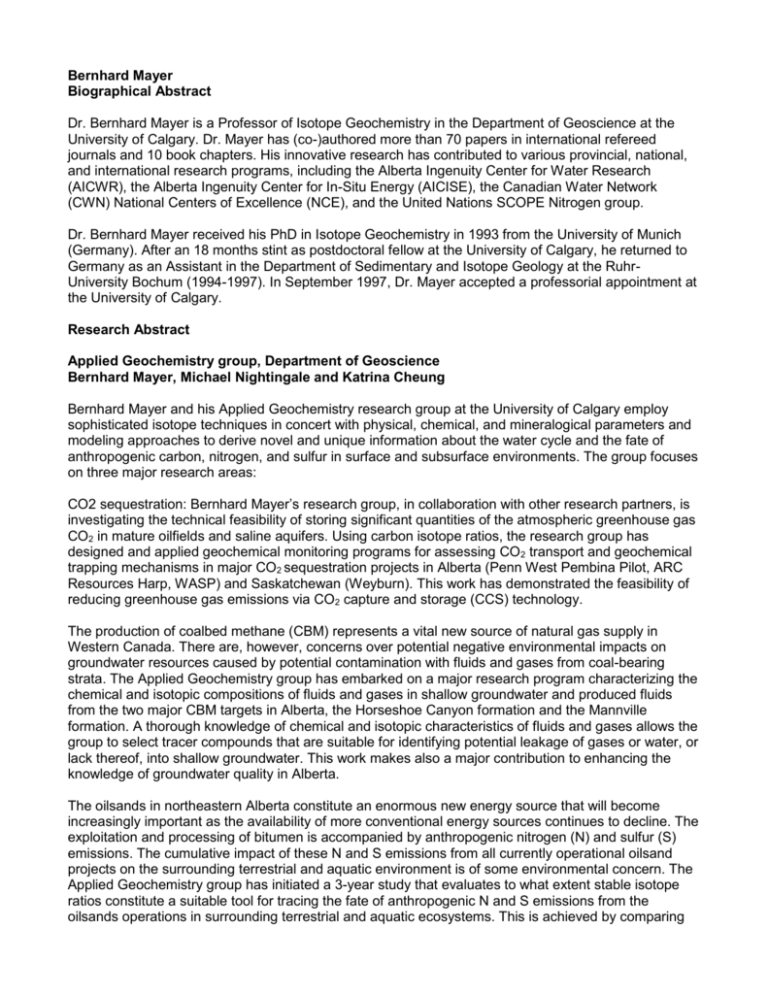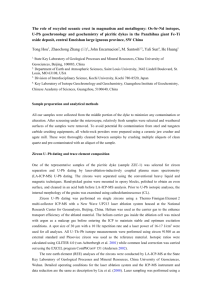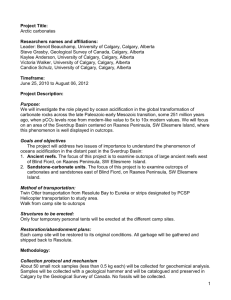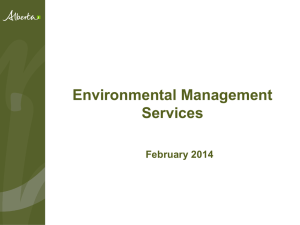Bernhard Mayer and his Applied Geochemistry research group at
advertisement

Bernhard Mayer Biographical Abstract Dr. Bernhard Mayer is a Professor of Isotope Geochemistry in the Department of Geoscience at the University of Calgary. Dr. Mayer has (co-)authored more than 70 papers in international refereed journals and 10 book chapters. His innovative research has contributed to various provincial, national, and international research programs, including the Alberta Ingenuity Center for Water Research (AICWR), the Alberta Ingenuity Center for In-Situ Energy (AICISE), the Canadian Water Network (CWN) National Centers of Excellence (NCE), and the United Nations SCOPE Nitrogen group. Dr. Bernhard Mayer received his PhD in Isotope Geochemistry in 1993 from the University of Munich (Germany). After an 18 months stint as postdoctoral fellow at the University of Calgary, he returned to Germany as an Assistant in the Department of Sedimentary and Isotope Geology at the RuhrUniversity Bochum (1994-1997). In September 1997, Dr. Mayer accepted a professorial appointment at the University of Calgary. Research Abstract Applied Geochemistry group, Department of Geoscience Bernhard Mayer, Michael Nightingale and Katrina Cheung Bernhard Mayer and his Applied Geochemistry research group at the University of Calgary employ sophisticated isotope techniques in concert with physical, chemical, and mineralogical parameters and modeling approaches to derive novel and unique information about the water cycle and the fate of anthropogenic carbon, nitrogen, and sulfur in surface and subsurface environments. The group focuses on three major research areas: CO2 sequestration: Bernhard Mayer’s research group, in collaboration with other research partners, is investigating the technical feasibility of storing significant quantities of the atmospheric greenhouse gas CO2 in mature oilfields and saline aquifers. Using carbon isotope ratios, the research group has designed and applied geochemical monitoring programs for assessing CO2 transport and geochemical trapping mechanisms in major CO2 sequestration projects in Alberta (Penn West Pembina Pilot, ARC Resources Harp, WASP) and Saskatchewan (Weyburn). This work has demonstrated the feasibility of reducing greenhouse gas emissions via CO2 capture and storage (CCS) technology. The production of coalbed methane (CBM) represents a vital new source of natural gas supply in Western Canada. There are, however, concerns over potential negative environmental impacts on groundwater resources caused by potential contamination with fluids and gases from coal-bearing strata. The Applied Geochemistry group has embarked on a major research program characterizing the chemical and isotopic compositions of fluids and gases in shallow groundwater and produced fluids from the two major CBM targets in Alberta, the Horseshoe Canyon formation and the Mannville formation. A thorough knowledge of chemical and isotopic characteristics of fluids and gases allows the group to select tracer compounds that are suitable for identifying potential leakage of gases or water, or lack thereof, into shallow groundwater. This work makes also a major contribution to enhancing the knowledge of groundwater quality in Alberta. The oilsands in northeastern Alberta constitute an enormous new energy source that will become increasingly important as the availability of more conventional energy sources continues to decline. The exploitation and processing of bitumen is accompanied by anthropogenic nitrogen (N) and sulfur (S) emissions. The cumulative impact of these N and S emissions from all currently operational oilsand projects on the surrounding terrestrial and aquatic environment is of some environmental concern. The Applied Geochemistry group has initiated a 3-year study that evaluates to what extent stable isotope ratios constitute a suitable tool for tracing the fate of anthropogenic N and S emissions from the oilsands operations in surrounding terrestrial and aquatic ecosystems. This is achieved by comparing the isotopic characteristics of N and S compounds in industrial emissions to those in environmental receptors including wet and dry deposition, likens, foliage, soils, and surface waters. Environmental monitoring will play an increasingly important role in the sustainable development of the energy reserves in the Athabasca Oilsands Region of northeastern Alberta. All these isotopic tracer projects have in common that they provide unique information about the sources and the fate of water and anthropogenic sulfur, nitrogen and carbon in air, plants, soil, surface water, groundwater and formation water that cannot be obtained by any other scientific technique. Therefore, this research makes innovative contributions to enhancing sustainable use and development of water and energy resources while minimizing the impact on terrestrial and aquatic ecosystems.











